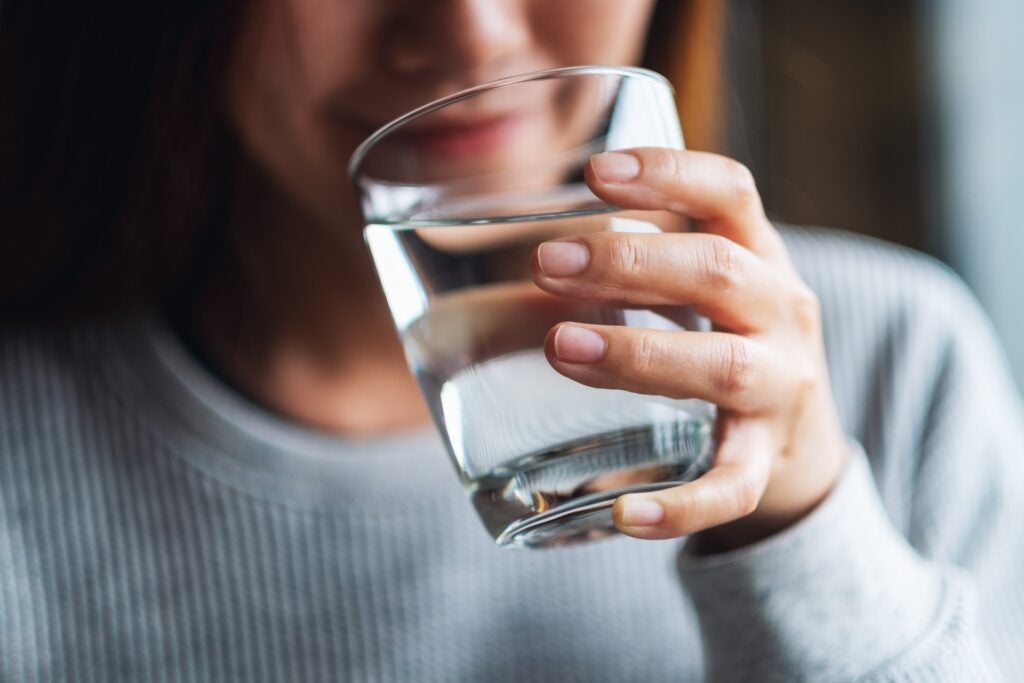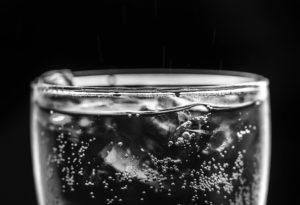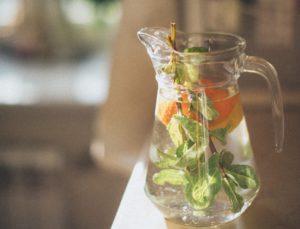
There are many options for what to drink, but water is the best choice for most people who have access to safe drinking water. It is calorie-free and as easy to find as the nearest tap.
Water helps to restore fluids lost through metabolism, breathing, sweating, and the removal of waste. It helps to keep you from overheating, lubricates the joints and tissues, maintains healthy skin, and is necessary for proper digestion. It’s the perfect zero-calorie beverage for quenching thirst and rehydrating your body.
How Much Water Do You Need?
Water is an essential nutrient at every age, so optimal hydration is a key component for good health. Water accounts for about 60% of an adult’s body weight. We drink fluids when we feel thirst, the major signal alerting us when our body runs low on water. We also customarily drink beverages with meals to help with digestion. But sometimes we drink not based on these factors but on how much we think we should be drinking. One of the most familiar sayings is to aim for “8 glasses a day,” but this may not be appropriate for every person.
General recommendations for daily water intake
The National Academy of Medicine suggests an adequate intake of daily fluids of about 13 cups and 9 cups for healthy men and women, respectively, with 1 cup equaling 8 ounces. Higher amounts may be needed for those who are physically active or exposed to very warm climates. Lower amounts may be needed for those with smaller body sizes (the chart below lists daily water intake based on age group from the National Academy of Medicine). It’s important to note that these amounts are not a daily target, but a general guide. In the average person, drinking less will not necessarily compromise one’s health as each person’s exact fluid needs vary, even day-to-day.
| Age | Daily Adequate Intake |
| 1-3 years | 4 cups, or 32 ounces |
| 4-8 years | 5 cups, or 40 ounces |
| 9-13 years | 7-8 cups, or 56-64 ounces |
| 14-18 years | 8-11 cups, or 64-88 ounces |
| men, 19 and older | 13 cups, or 104 ounces |
| women, 19 and older | 9 cups, or 72 ounces |
| pregnant women | 10 cups, or 80 ounces |
| breastfeeding women | 13 cups, or 104 ounces |
Other considerations for daily water intake
- About 20% of our total water intake comes not from beverages but from water-rich foods, particularly fruits and vegetables including lettuce, leafy greens, cucumbers, bell peppers, summer squash, celery, berries, and melons.
- Fever, exercise, exposure to extreme temperature climates (very hot or cold), and excessive loss of body fluids (such as with vomiting or diarrhea) will increase fluid needs.
- The amount and color of urine can provide a rough estimate of adequate hydration. Generally the color of urine darkens the more concentrated it is (meaning that it contains less water). However, foods, medications, and vitamin supplements can also change urine color. [1] Smaller volumes of urine may indicate dehydration, especially if also darker in color.
- Alcohol can suppress anti-diuretic hormone, a fluid-regulating hormone that signals the kidneys to reduce urination and reabsorb water back into the body. Without it, the body flushes out water more easily. Enjoying more than a couple of drinks within a short time can increase the risk of dehydration, especially if taken on an empty stomach. To prevent this, take alcohol with food and sips of water.
- Although caffeine has long been thought to have a diuretic effect, potentially leading to dehydration, research does not fully support this. The data suggest that more than 180 mg of caffeine daily (about two cups of brewed coffee) may increase urination in the short-term in some people, but will not necessarily lead to dehydration. Therefore, caffeinated beverages including coffee and tea can contribute to total daily water intake.
Are there benefits to drinking alkaline water?
Like most trends of the moment, alkaline water has become popular through celebrity backing with claims ranging from weight loss to curing cancer. The theory behind alkaline water is the same as that touting the benefits of eating alkaline foods, which purportedly counterbalances the health detriments caused by eating acid-producing foods like meat, sugar, and some grains.
From a scale of 0-14, a higher pH number is alkaline; a lower pH is acidic. The body tightly regulates blood pH levels to about 7.4 because veering away from this number to either extreme can cause negative side effects and even be life-threatening. However, diet alone cannot cause these extremes; they most commonly occur with conditions like uncontrolled diabetes, kidney disease, chronic lung disease, or alcohol abuse.
Alkaline water has a higher pH of about 8-9 than tap water of about 7, due to a higher mineral or salt content. Some water sources can be naturally alkaline if the water picks up minerals as it passes over rocks. However, most commercial brands of alkaline water have been manufactured using an ionizer that reportedly separates out the alkaline components and filters out the acid components, raising the pH. Some people add an alkaline substance like baking soda to regular water.
Scientific evidence is not conclusive on the acid-alkaline theory, also called the acid-ash theory, stating that eating a high amount of certain foods can slightly lower the pH of blood especially in the absence of eating foods supporting a higher alkaline blood pH like fruits, vegetables, and legumes. Controlled clinical trials have not shown that diet alone can significantly change the blood pH of healthy people. Moreover, a direct connection of blood pH in the low-normal range and chronic disease in humans has not been established.
BOTTOM LINE: If the idea of alkaline water encourages you to drink more, then go for it! But it’s likely that drinking plain regular water will provide similar health benefits from simply being well-hydrated—improved energy, mood, and digestive health
Preventing Dehydration: Is Thirst Enough?

A healthy body is designed to send thirst signals when the body becomes depleted of fluids. Thirst is the desire to drink, and is not only driven by physiological cues but behavioral cues. An example of a behavioral prompt is water temperature; research suggests that people tend to drink the most water when it is served at room temperature even though cooler drinks are rated as most pleasing to taste. We are also often influenced to drink (and eat) more in social settings.
As we age, however, the body’s regulation of fluid intake and thirst decline. Research has shown that both of these factors are impaired in the elderly. A Cochrane review found that commonly used indicators of dehydration in older adults (e.g., urine color and volume, feeling thirsty) are not effective and should not be solely used. Certain conditions that impair mental ability and cognition, such as a stroke or dementia, can also impair thirst. People may also voluntarily limit drinking due to incontinence or difficulty getting to a bathroom.
In addition to these situations, research has found that athletes, people who are ill, and infants may not have an adequate sense of thirst to replete their fluid needs. Even mild dehydration may produce negative symptoms, so people who cannot rely on thirst or other usual measures may wish to use other strategies. For example, aim to fill a 20-ounce water bottle four times daily and sip throughout the day, or drink a large glass of water with each meal and snack.
Symptoms of dehydration
These symptoms of dehydration may occur with as little as a 2% water deficit:
- Fatigue
- Confusion or short-term memory loss
- Mood changes like increased irritability or depression
Risks of dehydration
Dehydration can increase the risk of certain medical conditions:
- Urinary tract infections
- Kidney stones
- Gallstones
- Constipation
Is It Possible To Drink Too Much Water?
There is no Tolerable Upper Intake Level for water because the body can usually excrete extra water through urine or sweat.
However, a condition called water toxicity is possible in rare cases, in which a large amount of fluids is taken in a short amount of time, which is faster than the kidney’s ability to excrete it. This leads to a dangerous condition called hyponatremia in which blood levels of sodium fall too low as too much water is taken. The excess total body water dilutes blood sodium levels, which can cause symptoms like confusion, nausea, seizures, and muscle spasms.
Who is most at risk for hyponatremia?
- Hyponatremia is usually only seen in ill people whose kidneys are not functioning properly or under conditions of extreme heat stress or prolonged strenuous exercise where the body cannot excrete the extra water.
- Very physically active people such as triathletes and marathon runners are at risk for this condition as they tend to drink large amounts of water, while simultaneously losing sodium through their sweat.
- Women and children are also more susceptible to hyponatremia because of their smaller body size.
Healthy Hydration Tips

Water is an excellent calorie-free, sugar-free choice. For some people who are accustomed to drinking sweet beverages, water can initially taste bland. To increase water consumption without losing flavor or to spice up your daily water intake, try these refreshing water-based beverages:
Infused water
Instead of purchasing expensive flavored waters in the grocery store, you can easily make your own at home. Try adding any of the following to a cold glass or pitcher of water:
- Sliced citrus fruits or zest (lemon, lime, orange, grapefruit)
- Crushed fresh mint
- Peeled, sliced fresh ginger or sliced cucumber
- Crushed berries
Sparkling water with a splash of juice
Sparkling juices may have as many calories as sugary soda. Instead, make your own sparkling juice at home with 12 ounces of sparkling water and just an ounce or two of juice. For additional flavor, add sliced citrus or fresh herbs like mint.
Ditch single-use plastic water bottles
For the health of the planet, reconsider relying on single-use plastic water bottles and purchase a colorful 20-32 ounce refillable water thermos that is easy to wash and tote with you during the day.
Are seltzers and other fizzy waters safe and healthy to drink?
Water becomes bubbly through the process of carbonation and is sometimes suggested as a healthier alternative to soda. Carbonation involves dissolving carbon dioxide gas in water under high pressure; when the pressure is released, bubbles form. This process lowers the pH of water from 7 to 4, which is more acidic. The acid level has raised concerns that seltzer and soda water may harm dental enamel or bone health. However, research has not shown that carbonated beverages are associated with dental decay unless they also contain sugar or other sweeteners like high fructose corn syrup. Furthermore, studies have not found that carbonated beverages are associated with decreased bone mineral density; the culprit is more likely the high phosphorus content specific to dark cola soft drinks than the carbonation.
BOTTOM LINE: Carbonated waters, if unsweetened, are safe to drink and a good beverage choice. They are not associated with health problems that are linked with sweetened, carbonated beverages like soda. However, while it is great to replace soda with carbonated water, for oral health, it should not be used as a replacement for water with fluoride.
About This Page
Written by: Nancy Oliveira, MS, RD, LDN, CDCES
Reviewed by: Erica Kenney, ScD
Updated: February 26, 2025
View page history
- February 26, 2025
- Copyedited
- September 1, 2019
- Page published
- Content and evidence reviewed
Sources
View source list
- Hooper L, Abdelhamid A, Attreed NJ, Campbell WW, Channell AM, et al. Clinical symptoms, signs and tests for identification of impending and current water-loss dehydration in older people. Cochrane Database Syst Rev. 2015 Apr 30;(4):CD009647.
- Institute of Medicine. 2005. Dietary References Intakes for Water, Potassium, Sodium, Chloride, and Sulfate. Dietary Reference Intakes for Water, Potassium, Sodium, Chloride, and Sulfate. Washington, DC: The National Academies Press.
- Millard-Stafford M, Wendland DM, O’Dea NK, Norman TL. Thirst and hydration status in everyday life. Nutr Rev. 2012 Nov;70 Suppl 2:S147-51.
Explore More
- Harvard T.H. Chan School of Public Health is a member of the Nutrition and Obesity Policy Research and Evaluation Network’s (NOPREN) Drinking Water Working Group. A collaborative network of the Centers for Disease Control and Prevention, the NOPREN Drinking Water Working Group focuses on policies and economic issues regarding free and safe drinking water access in various settings by conducting research and evaluation to help identify, develop and implement drinking-water-related policies, programs, and practices. Visit the network’s website to access recent water research and evidence-based resources.
- The Harvard Prevention Research Center on Nutrition and Physical Activity provides tools and resources for making clean, cold, free water more accessible in environments like schools and afterschool programs, as well as tips for making water more tasty and fun for kids.

